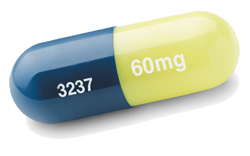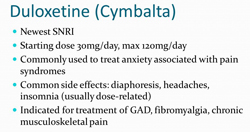Cymbalta (Duloxetine)
It has become increasingly clear that depressed patients quite often suffer from some degree of physical pain, which may adversely impact treatment outcome. Indeed, research suggests that as the pain severity of patients increases, the odds of achieving a successful antidepressant response decreases. Given that pain is associated with poor treatment response, a clear need exists for treatments that can effectively target both depression and physical pain.
Cymbalta (duloxetine) is a serotonin and norepinephrine reuptake inhibitor. It increases serotonin and norepinephrine activity in the brain, which regulate mood. Cymbalta is in a class of drugs known as dual uptake inhibitors. Cymbalta medically formulated as Duloxetine Hydrochloride is a new revolutionary antidepressent. What is interesting is that it is serotonin and noradrenaline uptake inhibitor in which previously only Effexor was the only FDA approved drug it that class. At this time very few effectiveness studies are available for cymbalta.

For neuropathic pain, Cymbalta has been compared with placebo in diabetic adults. The main measure of effectiveness was the change in the severity of pain each week. These studies showed that Cymbalta was more effective at reducing pain than placebo. In both studies, pain reduction was seen from the first week of treatment. While Cymbalta appears to offer nothing special for pain accompanying depression, it is still possible that it is more robust than other antidepressants for other pain conditions, such as diabetic neuropathy and fibromyalgia.
Why is this drug prescribed?
Cymbalta offers relief from both the emotional and physical symptoms that are associated with depression. Cymbalta is indicated for the treatment of major depressive disorder, as well as for the management of diabetic peripheral neuropathic pain. This antidepressant called duloxetine improved symptoms of fibromyalgia a chronic and painful musculoskeletal disorder in women.
The half-life of duloxetine is 10 to 15 hours. Steady-state is usually achieved after 3 days. It may take 2 to 3 days for duloxetine to clear out of the system. It usually takes 1-4 weeks to see improvements in symptoms and may take up to 4 to 7 weeks to achieve the remission.
What is this drug used for?
Depression
Anxiety
Diabetic neuropathy (nerve damage)
Fibromyalgia
Chronic muscle pain
Urinary incontinence (women)
Cymbalta works to help restore the balance of two naturally occurring chemicals in the brain and body: serotonin and norepinephrine. These chemicals play a role in both depression and diabetic peripheral neuropathic pain.
Reasons to buy Cymbalta:
- Cymbalta (duloxetine) may help relieve nerve pain from diabetes and other forms of chronic pain.
- Cymbalta (duloxetine) has several uses, which may be good for people with multiple conditions.
- Available as a generic, which is cheaper.
- Reduces painful physical symptoms of depression
- Low risk of weight gain with short-term treatment
- Lower rate of sexual side effects that with SSRIs
- Antidepressant effects may be noticed after one week
- Convenience of once-daily dosing
- Low risk of duloxetine emergent hypomania, mania, or hypomanic like symptoms
- Specifically studied for pain
- Relatively low cardiovascular risks
- Effective in elderly patients with recurrent major depressive disorder
- Effective in the prevention of depression relapse
Warnings and Precautions
Cymbalta (duloxetine) may not be a good option if you're a heavy drinker, or have liver or kidney problems. It can increase high blood pressure. Like most antidepressants, Cymbalta can cause higher risk of suicidal thoughts and behavior for people aged 24 and younger.
- You should discuss your overall health with your prescribing doctor when considering Cymbalta, as they'll need to measure the risks and benefits associated with your taking this particular drug.
- Like any drug, Cymbalta may not be right for everyone, so your doctor along with you will have to work together to decide if this is right for you.
- If you have taken an MAOI type drug such as Marplan, Nardil, or Parnate in the few weeks you should wait awhile until you begin taking Cymbalta. The majority of people are not on an MAOI type drug, so it's likely that is precaution does not apply to you, but if it does you and your doctor should take this warning seriously.
- Very serious complications often arise when MAOI and SNRI types of drugs are mixed, and the complications can be fatal.
- You should mention any drugs that you have been on for the last three to six months before starting Cymbalta. Many people don't realize that many drugs remain in the system for days or even weeks after they are discontinued, so it's very important to talk to your doctor to be sure that you will not suffer from any ill-advised drug combinations.
- You should tell your doctor if you are suffering from any medical conditions, even if they do not seem to relate to your depression or neuropathy in any way.
- You should specially mention kidney or liver disease, diabetes, narrow angle glaucoma, high blood pressure, seizure, bipolar disorder, suicidal thoughts, or if you drink alcohol regularly. These conditions do not necessarily mean that you cannot take Cymbalta; it may just mean that your doctor will have to prescribe more carefully and monitor your health closely.
- It may take between 1 to 4 weeks before the full benefit of this drug takes effect. Inform your doctor if your condition persists or worsens.
Contraindications
You can have a greater risk of suicidal thoughts or behavior at the beginning of the treatment with a drug of antidepressant. While you take Cymbalta you will have to be supervised to worsen of the symptoms of depression and suicidal thoughts during the first weeks of the treatment, or all the times that your amount is changed. In more of you observing for changes of your own symptoms, your family or others caregivers should be alert with the changes of your mood or symptoms.
Avoid employing other medicines which return to you somnolent. Such as the drug of pain, the relaxers of muscle, medicine for seizures, any other drug for the depression or concern. They can add to the somnolence caused by Cymbalta.

You may have unspecified following side effects: changes of mood, concern, attacks of panic, trouble sleeping, irritability, agitation, aggressiveness, serious agitation, mania, thought of suicide or being wounded. Cymbalta can cause the side effects which can deteriorate your thought or reactions. Take attention if you lead or do all that requires you to be waked up and alert.
While some effects of duloxetine on painful symptoms can be accounted for its antidepressant action, the data strongly suggests that duloxetine also exerts a substantial direct analgesic effect over and above its antidepressant effects, in patients with major depressive disorder, diabetic peripheral neuropathic pain, and fibromyalgia syndrome.
How to use Cymbalta
Cymbalta is available as gastroresistant capsules (30 mg and 60 mg). It means that the capsules contents pass through the stomach without being broken down until they reach the intestine. This prevents the active substance being destroyed by the acid in the stomach.
For major depression, the recommended dose of Cymbalta is 60 mg once a day. A response is usually seen in two to four weeks. In patients who respond to Duloxetine, treatment should continue for several months to prevent the disease coming back, or for longer in patients who have had repeated periods of depression in the past.
For diabetic neuropathic pain, the recommended dose is 60 mg per day but some patients may need a higher dose of 120 mg per day. The response to treatment should be assessed regularly.
For generalised anxiety disorder, the recommended starting dose is 30 mg once a day, but the dose can be increased to 60, 90 or 120 mg depending on the patient's response. Most patients will need to take 60 mg per day. Patients who also have major depression should start with 60 mg once a day. In patients who respond to Cymbalta, treatment should continue for several months, to prevent the disorder coming back.
At this point, there is no convincing clinical trial data suggesting that Cymbalta relieves the pain accompanying depression more than any other antidepressant. To summarize, Cymbalta appears little better than a placebo in alleviating pain in depression and is more effective than other, and probably by extension, other SSRIs, in treating such symptoms.
Antidepressants
Sleeping Pills
Anxiety
Depression Basics
Bipolar Disorder
Men Depression
Women Depression
- Depression in Women as a common problem
- Social & Cultural causes of Women Depression
- Female Depression & Suicide
- Why Women Depression is More Common Than Men
- Top 10 Causes of Female Depression
- How Friends & Family Can Help a Depressed Woman
- List of Sources Depressed Women Get Help
- Female Depression Symptoms
- More Female Depression Symptoms
